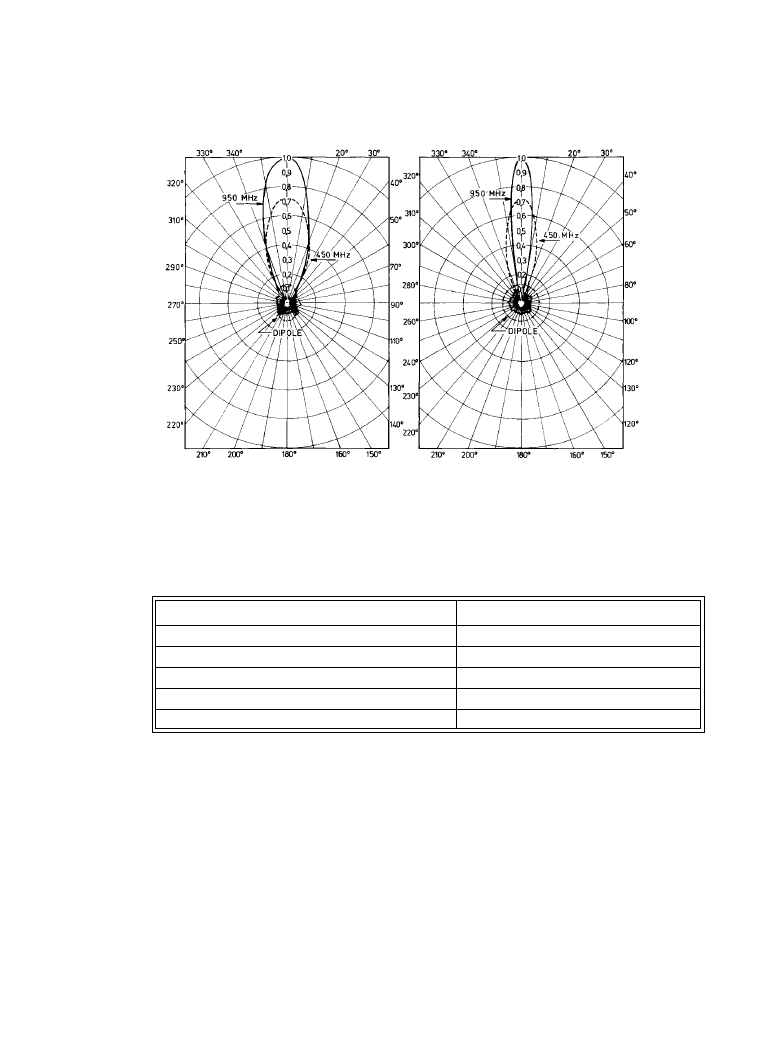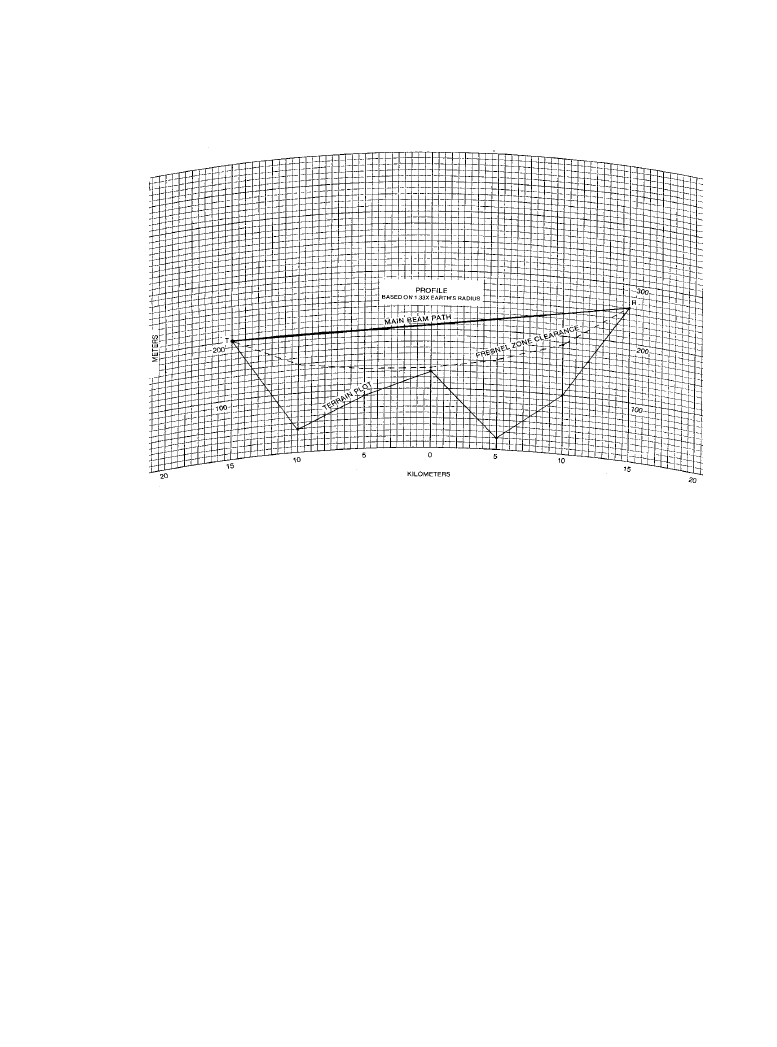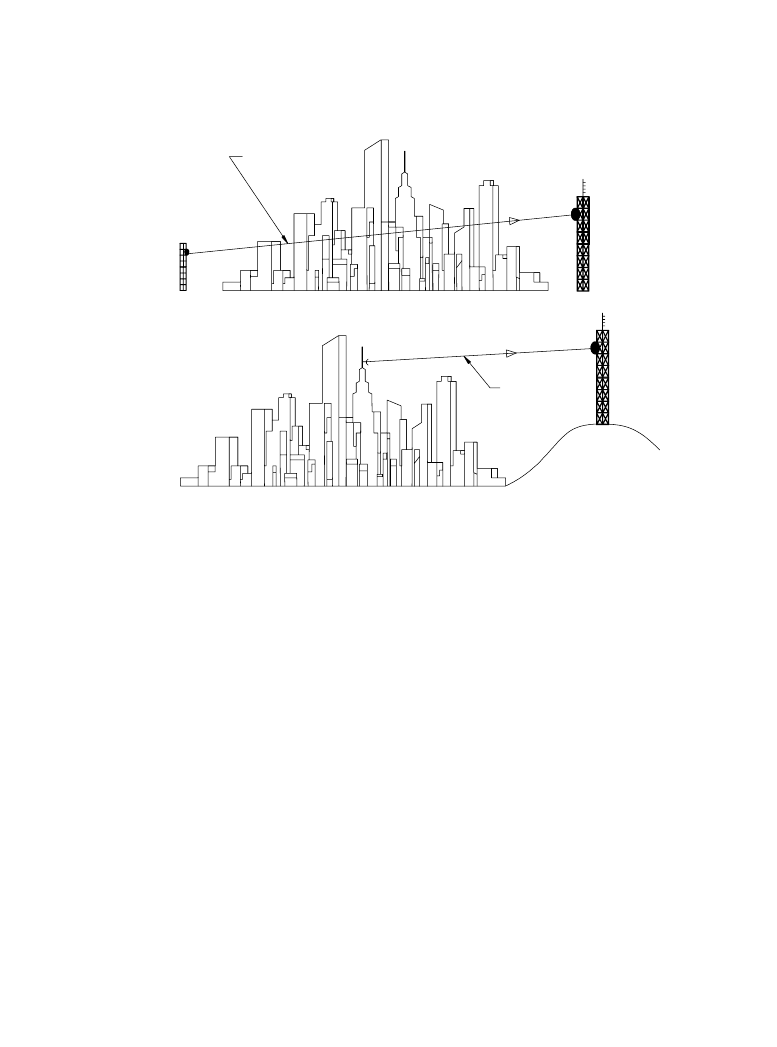ВУЗ: Казахская Национальная Академия Искусств им. Т. Жургенова
Категория: Книга
Дисциплина: Не указана
Добавлен: 03.02.2019
Просмотров: 21663
Скачиваний: 19

11-82 Broadcast Transmission Systems
11.4.3 System Planning
The ultimate goal in selecting STL equipment is to choose a combination of STL transmitter,
transmission line, antennas, and STL receiver that will give adequate quieting (S/N) when trans-
mitting over the path between the studio and the station transmitter. Allowance in the form of
fade margin must also be made for the uncertainties that the path imposes on the received signal.
The STL transmitter supplies the operating power that drives the system. The transmit and
receive antennas add gain to the link. All remaining components add loss. By far the greatest loss
results from the path itself. Passive components of the system, including the transmission line,
connectors, and pigtail cables, also add loss. All gains and losses must be taken into account to
(
a)
(
b)
Figure 11.4.15
Radiating plots for a parabolic section antenna at 450 MHz and 950 MHz: (
a) hori-
zontal response, (
b) vertical response. (After [2].)
Table 11.4.6 Typical Isotropic Gain for Full Parabolic Antennas at 950 MHz
Antenna Diameter
Isotropic Gain
4 feet
18.9 dBi
5 feet
21.0 dBi
6 feet
22.0 dBi
8 f eet
25.0 dBi
10 feet
27.0 dBi
Downloaded from Digital Engineering Library @ McGraw-Hill (www.digitalengineeringlibrary.com)
Copyright © 2004 The McGraw-Hill Companies. All rights reserved.
Any use is subject to the Terms of Use as given at the website.
Radio STL Systems

Radio STL Systems 11-83
ensure that the RF level at the receiver input is adequate. Losses should be minimized wherever
possible.
11.4.3a
Frequency Selection
Frequency selection would be a relatively simple procedure were it not for other broadcasters,
who also may be using STL frequencies, and perhaps sharing the same transmitter site. In prac-
tice, the choice of operating frequency is governed by the availability of unused STL channels in
the area, and is further dictated by the need to avoid interference with other STL users. The local
frequency coordinator (under the auspices of the Society of Broadcast Engineers in most areas of
the U.S.) usually can provide information on available frequencies and potential frequency con-
flicts.
STL engineering can be divided into three broad categories:
•
Frequency selection
•
Path layout
•
Path gain/loss calculations
Path layout concerns the factors affecting the physical location of the STL transmitter and
receiver, as well as the intended path. The goal in path layout is to ensure a correctly-oriented and
unobstructed route for unhampered propagation of the radio wave. Path gain/loss calculations
involve analyzing RF power levels from the transmitter output to the receiver input so that an
adequate receive level is provided.
Spectrum Considerations
In view of the serious spectrum congestion problems that exist today in many areas of the U.S.,
an STL system should be designed to be as spectrum-efficient as possible and—equally impor-
tant—to be as immune to undesired transmissions as possible. Even if the system will be oper-
ated in an area that currently does not have a spectrum congestion problem, there is no guarantee
that such a situation will not surface in the near future. In any event, a well-engineered system is
also a spectrum-efficient system.
The first rule of spectrum-efficiency is to use only the effective radiated power (ERP) neces-
sary to do the job. There is no justification for putting 15 W into the air when 5 W will provide
the required receiver quieting and fade margin.
A simple and sometimes effective spectrum coordination tool is cross-polarization. Two sta-
tions on nearby frequencies may achieve as much as 25 dB RF isolation through the use of differ-
ent polarizations of transmit antennas, matched by like polarization at their respective receive
antennas. Cross-polarization results in varying degrees of success, depending upon the frequency
of operation and the surrounding terrain.
11.4.3b
Path Layout
Careful path engineering should be performed prior to any licensing work to determine if the
proposed locations of the STL transmitter and receiver will be able to achieve the desired results.
There is much more to path engineering than simply pointing the transmitting and receiving
antennas at each other and turning the equipment on. Antennas cannot always be located in the
Downloaded from Digital Engineering Library @ McGraw-Hill (www.digitalengineeringlibrary.com)
Copyright © 2004 The McGraw-Hill Companies. All rights reserved.
Any use is subject to the Terms of Use as given at the website.
Radio STL Systems

11-84 Broadcast Transmission Systems
best possible geographic points because of space availability problems, excessive construction or
site rental costs, or local/federal licensing difficulties. In such cases, the required path is not the
ideal path and the link will have to be engineered around these fixed points.
Planning for any STL system should begin with an accurate, detailed U.S. Geological Survey
(USGS) map covering the proposed path. Note should be made of any natural obstructions (such
as mountains, hills, or vegetation) or man-made obstructions (such as buildings, water tanks, or
transmitting towers) in the path.
Line of Sight
Because microwave frequencies are used for STL systems, the signal path is theoretically limited
to the line-of-sight between the studio and transmitter locations. In reality, the radio horizon is
frequently situated beyond the visual horizon. This is the result of the gradual decrease in the
refractive index of the atmosphere with increasing altitude above the earth. This effect bends
radio waves downward. The degree of bending is characterized by the K factor, which is the ratio
of the effective earth radius to the true earth radius. A typical value for K is 4/3, or 1.33, valid
over 90 percent of the time in most parts of the world. For long paths, consult a map showing the
minimum K factor occurring in the specific area so that proper antenna heights can be planned.
Figure 11.4.16 plots an example path on 4/3 earth graph paper.
STL Site Selection
Usually, there is little choice for the STL transmitter and receiver locations, because most STL
systems will be required to provide a path between already determined studio and transmitter
points. If, however, a new studio location is being planned, the possible STL path is an important
consideration. Figure 11.4.17a illustrates a poor path. Generally speaking, a good path is literally
line-of-sight, with no obstructions to block the signal, and no other terrestrial or atmospheric
conditions that would compromise the path (Figure 11.4.17b.
Terrain Considerations
One of the major tasks required to engineer an STL system is the path analysis between the STL
transmitter at the studio and the STL receiver location. To determine what constitutes a clear
path, the concept of Fresnel zones for optical theory is applied to radio waves. Most of the elec-
tromagnetic energy at a receiving point is concentrated in an elliptical volume that is a function
of the distance between the transmit and receive points and the wavelength. The energy outside
this volume either cancels or reinforces the energy within the volume, depending on whether the
distance that the energy travels to the receive point is longer by an even or odd number of 1/4-
wavelengths. Even distances result in radio wave cancellations; odd distances result in radio
wave reinforcement. (See Figure 11.4.18.) The radius of the first Fresnel zone, which defines the
boundary of the elliptical volume, is given by the following:
(11.4.2)
Where:
F
1
= first Fresnel zone radius in feet
F
1
72.1
d
1
d
2
fD
-----------
=
Downloaded from Digital Engineering Library @ McGraw-Hill (www.digitalengineeringlibrary.com)
Copyright © 2004 The McGraw-Hill Companies. All rights reserved.
Any use is subject to the Terms of Use as given at the website.
Radio STL Systems

Radio STL Systems 11-85
d
1
= distance from the transmitting antenna to the obstruction in miles
D = total path length in miles
d
2
= D – d
1
in miles
f = frequency in GHz
H = distance from the top of the obstruction to the radio path
For reliable operation, obstructions should not project into the area thus defined. Empirical
studies, however, have shown that performance is substantially the same as long as H is greater
than 0.6 F
1
.
The first step in evaluating the path is to make a subjective check of the planned route. First,
determine that a reasonable possibility of success exists. Next, draw a best-case route for the
path. If obstructions are found, consider accomplishing the path by using a repeater system, or by
shifting the location of the STL transmit antenna. Although a detailed path analysis may not be
required in cases where line-of-sight is clearly present and the distance is less than about 10
miles, it is still good engineering practice to review some of the basic elements of the evaluation.
Obtain an accurate map showing the topography between the STL transmitter and receiver
locations. After determining the transmitter and receiver sites on the map, connect them with a
straight line showing the proposed path. After the path has been drawn, a protractor can be used
to determine the direction (azimuth) of the path in degrees from true North. This data will later
assist in antenna setup, and is necessary for filling out the appropriate FCC application.
Using the scale of miles on the map, measure the distance between the transmitter and
receiver sites. Determine the altitude of the proposed transmit antenna location from the contour
Figure 11.4.16
An aural STL path profile drawn on true-earth radius graph paper. (
After [2].)
Downloaded from Digital Engineering Library @ McGraw-Hill (www.digitalengineeringlibrary.com)
Copyright © 2004 The McGraw-Hill Companies. All rights reserved.
Any use is subject to the Terms of Use as given at the website.
Radio STL Systems

11-86 Broadcast Transmission Systems
lines on the map, and add to that the height of the building or other structure on which the
antenna will be mounted. Make a similar determination for the receive antenna location. Adjust
the heights to ensure that all obstructions are cleared. Depending on the path length and the
height of the antennas, it may be necessary to take the curvature of the earth into account, and
use earth radius graph paper to plot a cross-section of the path.
Study the map to see what terrain features are between the path points. Prior to making any
other evaluations, conduct a visual field survey. Check for any structures or features not listed on
the map. Anticipate any possible new construction or tree growth that may cause problems in the
future.
The terrain from the transmitting antenna to the receiving antenna must be examined not only
for obstructions, but for reflection possibilities as well. A large body of water will usually cause
problems for an STL system. If the water is an even number of Fresnel zones from the direct
path, signal attenuation will likely occur at the receiver. Temperature changes and tidal condi-
tions will also have an effect. Likewise, thick vegetation or forested areas can be reflective to RF
signals when wet, creating a similar (but not so troublesome) problem. Generally, the solution to
reflection conditions is to change either the transmitting or receiving antenna height. In extreme
cases, a diversity reception system may also be used.
Path Reliability
The long-term reliability of an STL path is determined in large part by the initial engineering
work done before the system is installed. Figure 11.4.19 charts gains and losses through a typical
Studio
site
Transmitter
site
Unacceptable path
site
Transmitter
Studio
site
Clear path
(
a)
(
b)
Figure 11.4.17
Path considerations in planning an STL: (
a) unacceptable path because of
obstructions, (
b) usable path. (After [2].)
Downloaded from Digital Engineering Library @ McGraw-Hill (www.digitalengineeringlibrary.com)
Copyright © 2004 The McGraw-Hill Companies. All rights reserved.
Any use is subject to the Terms of Use as given at the website.
Radio STL Systems